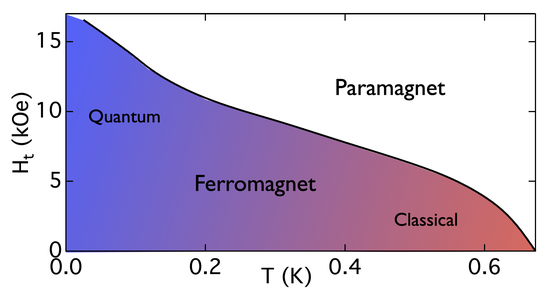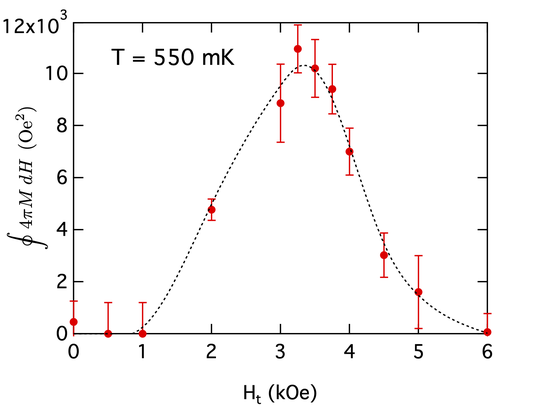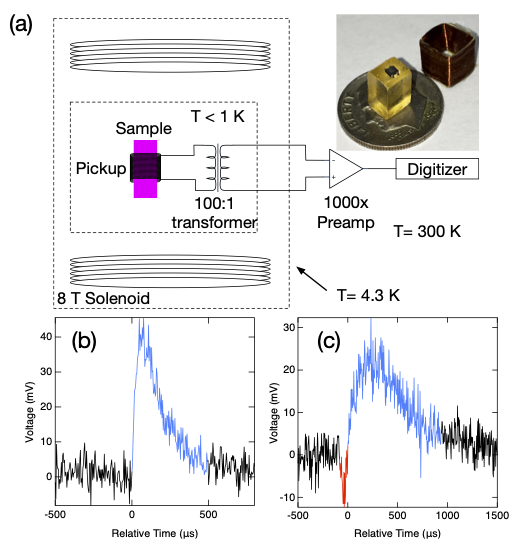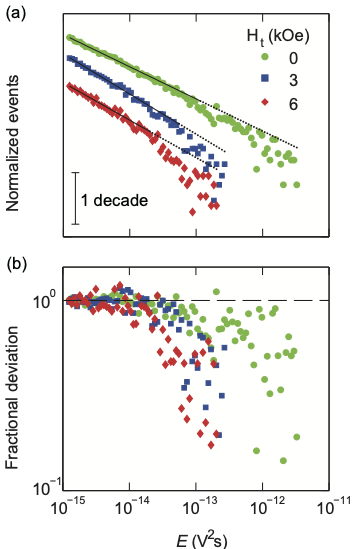Disorder in quantum and classical magnets
Disorder in Quantum Spins
Most physical and biological systems are disordered, even while the majority of theoretical models treat disorder as a weak perturbation. One particularly simple system is a ferromagnet approaching its Curie temperature, TC, where all of the spins associated with partially-filled atomic shells acquire parallel orientation, realized in the LiHoxY1-xF4 family of materials. With the addition of disorder via chemical substitution, the Curie point is suppressed, but no qualitatively new phenomena appear in bulk measurements as long as the disorder is truly random on the atomic scale and not so large as to eliminate ferromagnetism entirely. However, measurements in a a model, disordered magnet show that the magnetic response is singular above the Curie temperature, and that the associated singularity grows to an anomalous divergence at TC. The origin of the singular response is the random internal field induced by an external magnetic field transverse to the favoured direction for magnetization.
These internal random fields act as an isothermal regulator of domain pinning. At elevated temperatures, near the transition into the paramagnet, modest transverse fields increase the pinning, stabilize the domain structure, and harden the magnet, until a point where the field induces quantum tunneling of the domain walls and softens the magnet. At low temperatures, tunneling completely dominates the domain dynamics and provides an interpretation of the quantum phase transition in highly disordered magnets as a localization/delocalization transition for domain walls.
More reading:
Using Disorder to Tune Magnetism
The intended use of a magnetic material, from information storage to power conversion, depends crucially on its domain structure, traditionally crafted during materials synthesis. By contrast, an external magnetic field applied transverse to the preferred magnetization of a model disordered uniaxial ferromagnet is an isothermal regulator of domain pinning. At elevated temperatures, near the transition into the paramagnet, modest transverse fields increase the pinning, stabilize the domain structure, and harden the magnet, until a point where the field induces quantum tunneling of the domain walls and softens the magnet. At low temperatures, tunneling completely dominates the domain dynamics and provides an interpretation of the quantum phase transition in highly disordered magnets as a localization/delocalization transition for domain walls. While the energy scales of LiHo0.44Y0.56F4, the rare earth ferromagnet studied here, restrict the effects to cryogenic temperatures, the principles discovered are general and should be applicable to existing classes of highly anisotropic ferromagnets with ordering at room temperature or above.
More reading:
Switchable hardening of a ferromagnet at fixed temperature
Domain Dynamics in a Quantum Ferromagnet
A wide range of systems, from hard magnets to soft matter, from fluids to power grids, exhibit avalanche behavior when driven out of equilibrium. The statistics and form of these avalanches can be used to reveal the nature of the underlying energy landscape and dynamics. Barkhausen noise, driven by avalanches of ferromagnetic domain motion, is perhaps the best studied realization of this general phenomenon. In conventional metallic ferromagnets, drag effects arising from eddy-current back action dominate the dynamics, but realizing either a drag-free response or alternative drag mechanisms remains an important avenue for investigation. We measure Barkhausen noise in an insulating Ising ferromagnet, LiHo0.44Y0.56F4. An insulator cannot support eddy currents, and, indeed, we find that the ensemble average over long-duration avalanche events just below the Curie temperature approaches a symmetric lineshape, as expected for a drag-free response. This limit has not been observed previously in metallic ferromagnets. At lower temperatures and for short duration events, we do observe clear drag effects, which cannot arise from eddy currents. By studying the temperature dependence in different time regimes and comparing to the well-understood microscopic Hamiltonian of this model Ising magnet, we are able to propose the presence of two coexisting drag mechanisms: one arising from quantum-fluctuation-induced domain wall broadening and the other from random- field-induced domain wall pinning.
More reading:
Magnetic domain dynamics in an insulating quantum ferromagnet
Random-Field Physics in Classical Magnets
With sintered needles aligned and a magnetic field applied transverse to its easy axis, the rare- earth ferromagnet Nd2Fe14B becomes a room-temperature realization of the Random Field Ising Model. The transverse field tunes the pinning potential of the magnetic domains in a continuous fashion, as revealed by magnetic hysteresis measurements and return-point-memory studies. Further, we study the magnetic domain reversal and avalanche dynamics between liquid helium and room temperatures at a series of transverse fields using a Barkhausen noise technique. The avalanche size and energy distributions follow power-law behavior with a cutoff dependent on the pinning strength dialed in by the transverse field, consistent with theoretical predictions for Barkhausen avalanches in disordered materials. A scaling analysis reveals two regimes of behavior: one at low temperature and high transverse field, where the dynamics are governed by the randomness, and the second at high temperature and low transverse field where thermal fluctuations dominate the dynamics.
More reading:
Reversible Disorder in a Room Temperature Ferromagnet
Barkhausen noise in the Random Field Ising Magnet Nd2Fe14B






